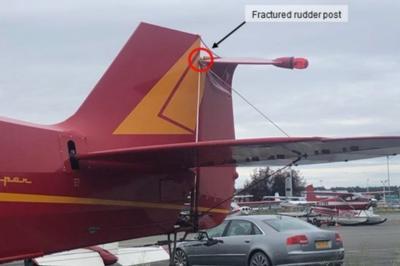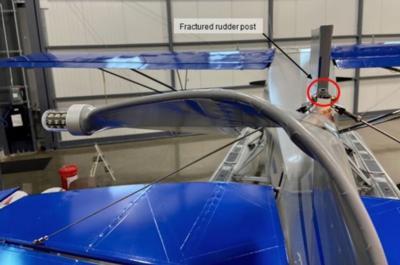Sat, Jan 29, 2022
Piper Cruisers May Require Replacement for Aging Rudder Posts
The results of an investigation into a number of incidents involving vintage Piper aircraft have been released, exposing a vulnerability in aircraft that have remained in service to the point that lifetime fatigue could take its toll to the point of breakage. Notable pictures of example aircraft show the upper portion of the rudder bent beyond 90°. The part in question can be found in Piper PA-12, PA-14, and PA-18s still in service.

A series of incidents with similar patterns of parts failure have been investigated by the NTSB, bringing about concerns over the steel selection used in Piper rudder posts built prior to 1974. The part number in question, 40622, is made of AISI 1025 carbon steel, which the NTSB says are "susceptible to fatigue cracking under normal service conditions." When originally certified in the 1940s, 40622 complied with the static load conditions required, but in service, the parts were subjected to dynamic alternating and fatigue loads throughout their lifetime. The NTSB found through structural analysis that "bending stresses on the rudder post from certification gust and maneuver loads are significantly closer to the endurance limit for rudder posts made of AISI 1025 carbon steel than they are for those made of AISI 4130 low-alloy steel." Investigation did identify corrosion, scratches, and surface wear on the examined parts, which further increased chances of failure due to stress-concentrating surface
features not available when new.
While the tested rudder posts all had beacons or strobes installed that increased susceptibility to failure, the board notes that even without the extra equipment, the in-service stresses probably exceed endurance limits for the original rudder post material. Aging, vintage aircraft could have more modern substitutions in service, if the rudder posts were replaced in line with AC-23-27. For now, the NTSB recommends operators watch out for the issue, and the FAA issues an airworthiness directive.

"Therefore, the NTSB recommends that the FAA issue an airworthiness directive that describes the safety risk associated with the continued use of Piper part number 40622 rudders equipped with a post made of AISI 1025 carbon steel and that requires owners and operators to address the unsafe condition, such as by replacing them with rudders equipped with a post made of AISI 4130 low-alloy steel or its equivalent."
More News
Aero Linx: Model Aeronautical Association of Australia MAAA clubs are about fun flying, camaraderie and community. For over 75 years, the MAAA has been Australia’s largest fl>[...]
Touchdown Zone Lighting Two rows of transverse light bars located symmetrically about the runway centerline normally at 100 foot intervals. The basic system extends 3,000 feet alon>[...]
“Discovery and innovation are central to our mission at Virgin Galactic. We’re excited to build on our successful record of facilitating scientific experiments in subor>[...]
How To Get A Story On Aero-TV News/Feature Programming How do I submit a story idea or lead to Aero-TV? If you would like to submit a story idea or lead, please contact Jim Campbel>[...]
Student Pilot Reported That During Rotation, “All Of A Sudden The Back Of The Plane Kicked To The Right..." Analysis: The student pilot reported that during rotation, “>[...]
 ANN's Daily Aero-Linx (05.02.24)
ANN's Daily Aero-Linx (05.02.24) ANN's Daily Aero-Term (05.02.24): Touchdown Zone Lighting
ANN's Daily Aero-Term (05.02.24): Touchdown Zone Lighting Aero-News: Quote of the Day (05.02.24)
Aero-News: Quote of the Day (05.02.24) ANN FAQ: Contributing To Aero-TV
ANN FAQ: Contributing To Aero-TV NTSB Final Report: Cirrus Design Corp SR20
NTSB Final Report: Cirrus Design Corp SR20




